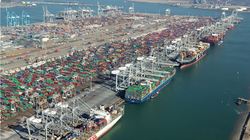Second wave of blankings could disrupt European exports

Falling import demand sees carriers announce massive cuts in capacity. But moves to maintain rates could make life for those sectors still looking to export from Europe.
First half of 2020 will see a 17% reduction in capacity on the Asia–Europe trade lane.
DEEPSEA networks are set to see further blank sailings in the coming weeks, which could coincide with a resumption of some business activity in Europe and put pressure on the continent’s exporters.
“We think that at least some of the blank sailings that we are seeing are not just suspended sailings, that is services being suspended or merged, so these may stay with us for some time,” said TIM Consult analyst Clemens Schapeler.
Moveover, moves by some carriers to reroute backhaul voyages to Asia around the Cape of Good Hope, thereby saving money on Suez Canal fees at a time of low bunker prices, is adding seven to 10 days for shippers exporting to Asia.
“Capacity is improving as we are moving out of the first wave of blankings, but it is almost certain that the second wave will hit us in approximately two weeks, which will bring about a further period of constrained capacity, lasting about four weeks, before we return to a new normal,” Mr Schapeler said in a webinar.
But that new normal would leave capacity at only around 90% of what it had previously been.
“The risk for shippers is that any recovery in Europe may be unfortunately timed as the second wave of capacity cuts comes into effect,” he said. “That could be an operational challenge. There are still some issues with empty equipment.”
Not all industries in Europe had been affected by the lockdowns designed to prevent the spread of coronavirus, added Mr Schapeler. “For example, paper manufacturers are still at full capacity. There could be serious struggles for European exporters.”
Asia-Europe westbound sailings will have seen a 12% reduction in capacity in April, according to Simon Sundboell, chief executive of Danish analyst eeSea.
The first-half reductions amount to a drop in deployed capacity of 17% to 9.5m teu compared with 11.2m teu in the same period a year earlier.
But this reduction in capacity had been critical in helping carriers maintain “relatively stable” freight rates, Mr Sundboell told Lloyd’s List.
“They’ve managed to take out 17% capacity in Asia–Europe headhaul, which has an impact on rates. We still don’t know whether, volume-wise, they are now sailing at better load factors. The fact that they have managed to take out capacity is a positive sign for lines, but I’d be surprised if the volume drop was only 17%.”
Container freight spot rates recorded by the Shanghai Shipping Exchange picked up slightly this week, with the Asia-Europe rate rising by 3.2% to $753 per teu, after last week falling to $725 per teu.
“According to the latest import and export data released by Chinese customs, the total value of China’s imports and exports to the EU in the first quarter of 2020 was Yuan875.9bn ($123.7bn), a year-on-year decrease of 10.4%,” the SSE said.
Figures from Drewry also indicated the impact on volumes of the coronavirus pandemic. Its port throughput index fell to 108 points in February, 15.6% down month on month and 4.4% down year on year. It was the largest monthly fall since the index launched in 2012.
Europe’s throughput index was down 2.7% compared with the previous month and reached 116.5 in February, although the annual fall was much lower at 1.4%, with the first wave Chinese supply-side impact expected to be most evident in the March figures.
“We expect the European downturn to accelerate in the next few months with the spread of the coronavirus into Europe supressing demand,” Drewry said.